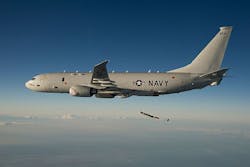Navy asks Boeing to upgrade networking, communications, and weapons aboard Poseidon aircraft
These improvements, part of a package of improvements expected to become operation in 2020, also will enhance the Poseidon's signals intelligence (SIGINT) capabilities, as well as its ability to network its onboard subsystems and network with other military systems.
Officials of the U.S. Naval Air Systems Command at Patuxent River Naval Air Station, Md., announced a $71.6 million order earlier this month to the Boeing Defense, Space & Security segment in Seattle to build, integrate, and test several Poseidon Increment 3 Block I capabilities.
This order to Boeing is part of the third of three phases of planned improvements to the Poseidon aircraft -- a ruggedized version of the Boeing 737 single-aisle jetliner hardened for long-range maritime patrol and anti-submarine warfare (ASW) missions.
Related: Raytheon to provide radar for P-8A Poseidon
Among the improvements involved in this order are Link 16 communications networking; the AGM-84N Harpoon II+ anti-ship missile; integrated broadcast system receiver and filtering; high-frequency (HF) radio upgrades; targeting improvements; and narrowband satellite communications (SATCOM) capability.
These upgrades pertain not only to U.S. P-8A Poseidon aircraft, but also for the Poseidon planes operated by the Australian military forces.
Link 16 is a U.S. and NATO military tactical data exchange network that enables military aircraft, ships, and ground forces to exchange their tactical picture in near-real time. It supports text messages, imagery data, and two channels of digital voice communications at 2.4 kilobits per second and 16 kilobits per second.
Boeing AGM-84N Harpoon Block II+ is an anti-ship and land-attack missile with over-the-horizon range. It has a common datalink and new Global Positioning System (GPS) satellite navigation guidance system. The Harpoon Block II+ is expected to be integrated aboard the Poseidon as the plane receives new networking capabilities.
Planned Poseidon Increment 3 Block II upgrades later are expected to improve the aircraft's radar abilities to identify, track, and attack threats on land and at sea with the Raytheon AN/APS-154 Advanced Airborne Sensor (AAS).
On this order Boeing will do the work in Puget Sound, Wash.; Grand Rapids, Mich.; St. Louis; Patuxent River, Md.; Dallas; Oklahoma City; and El Paso, Texas, and should be finished by February 2019.
For more information contact Boeing Defense, Space & Security online at www.boeing.com/defense, or Naval Air Systems Command at www.navair.navy.mil.
